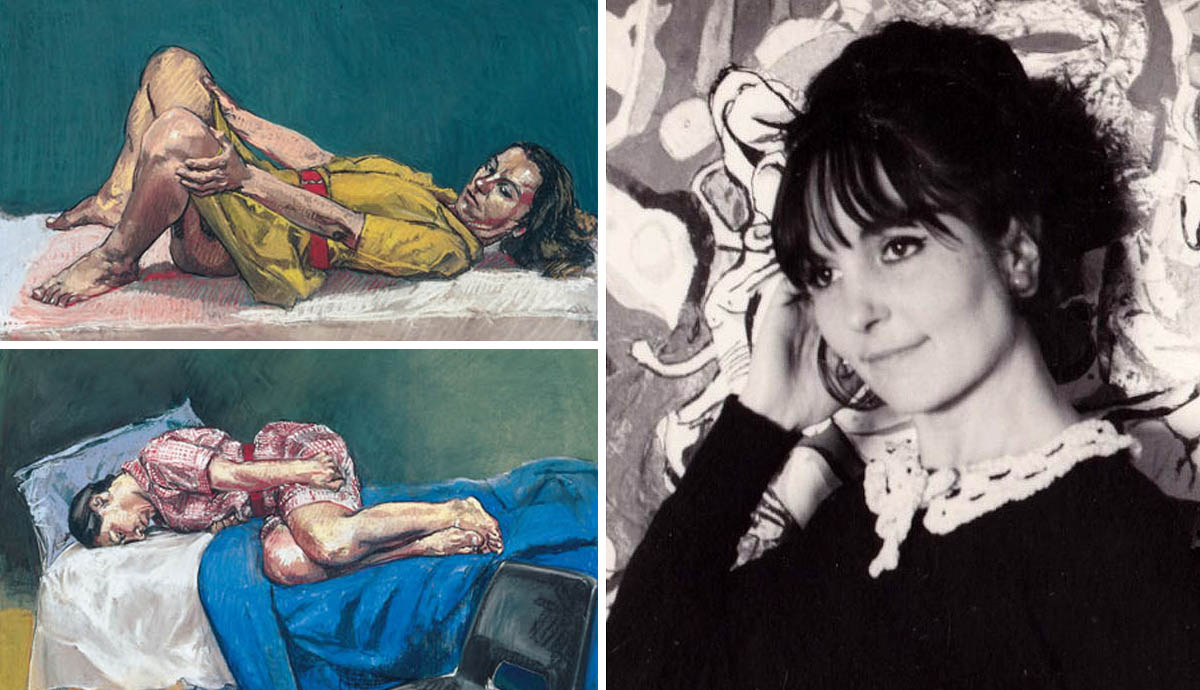
Paula Rego is one of the most influential figurative artists of her generation. Her work is celebrated for its crude, unflinching exploration of issues surrounding gender, rebellion, and power. Much of the artist’s career has centered around women’s rights, having been subject to the double oppression of being a woman in a patriarchal society and a citizen under fascism while growing up in her native Portugal. The artist is known for her unique ability to explicitly depict taboos and uncomfortable realities. As the access to safe and legal abortion becomes increasingly restricted around the world, we revisit Rego’s Abortion Series and her unsettling pastels which portray the aftermath of illegal abortion.
From Schoolgirl to Fierce Critic: The Making of Paula Rego

Born in Lisbon in 1935, Paula Rego grew up under the facist and repressive Estado Novo (New State) dictatorship of António de Oliveira Salazar. The authoritarian regime, which lasted an astonishing forty-eight years and only came to an end in 1974, meant that you were at serious risk of imprisonment and even torture if you dared question Salazar’s principles. The regime suppressed political freedom, made women’s road to equality a thing of the past, and crushed the poor even further down the social mobility ladder. It also forcefully maintained its African colonies long after two world wars and a depleted economy left the rest of Europe with little choice but to finally give up its colonial domains.
Because Paula Rego’s anglophile parents were fiercely anti-fascist, the artist was sent to the UK at the age of sixteen. Soon after graduating high school in Kent, Rego enrolled at London’s Slade School of Fine Art, where she studied under William Coldstream and L.S. Lowry and exhibited alongside David Hockney, Lucien Freud, and Victor Willing, the latter whom she later married and had three children with.

Paula Rego’s career effectively began in the early 1960s while she was living between the UK and Portugal. Throughout this decade, Rego’s overtly confrontational work expressed her deep resentment of the authoritarian regime she grew up oppressed by. At the age of twenty-five, she produced the work Salazar Vomiting the Homeland, in which semi-figurative forms depict the Portuguese dictator violently regurgitating bile, as seen in the bottom left-hand corner of the painting.

Unlike Rego’s later work, the narrative in Salazar Vomiting the Homeland is not immediately clear. The work, which at first glance appears abstract and therefore apolitical, elicits a feeling of intense discomfort as soon as the viewer is made aware of its title. The painting was the first of many that would establish Paula Rego as a bold critic of the Estado Novo and of social injustice as a whole.
In June 1998, a referendum to decriminalize abortion in Portugal was rejected. The referendum had been proposed in order to put an end to the estimated 20 to 50,000 illegal abortions in the country, which posed huge risks to women’s physical and mental well-being. A month later, Paula Rego began working on a series of ten untitled pastels, now known as her Abortion Series. They show women squatting, open-legged, in fetal positions, surrounded by household objects that highlight the lack of medical equipment. The works, which Rego completed over a period of six months, are a brutally honest depiction of backstreet abortions. They can also serve as compelling requests to respect a woman’s right to choose.
Responding to Portugal’s 1998 Referendum

In 2002, Paula Rego made a public statement following an abortion trial in Portugal which had sparked controversy across the country, explaining what drove her to explore the subject through her work: ‘The series was born from my indignation… It is unbelievable that women who have an abortion should be considered criminals. It reminds me of the past… I cannot abide the idea of blame in relation to this act. What each woman suffers in having to do it is enough.”
In Untitled No. 1, a young woman gazes out at the viewer, the stoic, yet pained look in her eyes almost impossible to meet. We are shown the dark reality of this woman’s circumstance. She is clearly not depicted in a hospital or clinic. The woman sits on a bed whilst clutching her splayed legs, a ceramic bowl by her side and a basin beneath her, both presumably there to aid the procedure in some way. The woman’s hair is held firmly back by a red bandana. She wears nothing but a loosely fitted blue tank top, which covers the area between her legs. This work forces us to confront the woman’s pain, while simultaneously it reminds us that there is no shame in her choice, nor the need for secrecy. Rather, the work highlights the danger women are ultimately forced to put themselves in when access to safe and legal abortions is restricted.
The Abortion Series: A Rallying Call for Change

In another work of Rego’s that belongs to her Abortion Series, we see a woman balancing herself in position, her legs propped open by flimsy camping chairs rather than gynecologist stirrups. Her sober, defiant gaze is just as unsettling as it is captivating: in her black and red summer dress, she looks on into the distance, appearing as prepared as she’ll ever be. Is she looking at the person who is about to help her terminate her pregnancy? Is her lover present, the other individual responsible for the situation she found herself in? Or worse, does the woman’s intense, almost indignant stare reveal something darker?

In her Abortion Series triptych, Rego turns the traditional reclining nude on its head. She controls the women’s gaze, and in turn, dictates ours just as well. Her women are not depicted as objects of desire, as in the famed works of artists like Matisse, Gauguin, and Picasso. Paula Rego purposefully keeps her subjects clothed. “I tried to do full-frontal,” she explains, “but I didn’t want to show blood, gore, or anything to sicken, because people wouldn’t look at it then. And what you want to do is make people look, make pretty colors and make it agreeable, and in that way make people look at life.” Paula Rego paints as a bystander to these procedures. She is a witness to the women’s physical burden, but equally, to their unflappable bravery. Her women are not merely to be pitied, they are to be respected and understood.
Women’s Reproductive Rights and Paula Rego

Paula Rego’s Abortion Series had a significant impact. The pastels, along with a series of etchings, were disseminated widely and shown in various Portuguese newspapers. The series has been credited as having swayed public opinion in Portugal, leading to a second referendum in 2007 which finally legalized abortion. Rego’s explicit studies of illegal abortions made one thing especially clear. Restricting a woman’s access to abortion will not prevent her from seeking the procedure elsewhere: it will simply make the process extremely dangerous.
In the present day, a woman’s right to safe and legal abortion is being threatened across the world. While over 95% of European women of reproductive age live in countries where abortion is technically legal, a number of restrictive laws still make the procedure unnecessarily difficult to access for many. In fifteen European countries, including Italy, Portugal, Spain, Germany, and Hungary, mandatory waiting periods compromise women’s access to timely care when requesting an abortion. Legal time barriers continue to be a major issue, particularly in the case of women from low-income, underrepresented, and marginalized communities who may not be able to access adequate healthcare within the legal timeframe. For many of these women, seeking illegal abortions might be the only viable option.

Paula Rego has spoken openly about several abortions she has had herself, emphasizing how restrictive reproductive laws disproportionately affected poorer women in her native Portugal: “If you were rich,” she explains, “it was easier to find a safe way to have an abortion, usually by traveling to another country.” Poor women, Rego said, were “butchered.” In the United States, nationwide legal abortion may be a thing of the past. It has been forty-nine years since the 1973 Supreme Court ruling in Roe v. Wade affirmed a women’s right to request an abortion. But with Roe v. Wade at serious risk of being overturned, thousands of American women may be denied the fundamental right to abortion.
In Alabama, abortion is only legal in rare exceptions, such as rape or incest. In Texas, the legislation bans women from terminating a pregnancy after six weeks, before most women are aware that they are pregnant. The Texas ban also encourages citizens to sue anyone who “aids or abets” a woman trying to get an abortion, such as an Uber driver who has, knowingly or unknowingly, driven a woman to an abortion clinic.

In a piece for the Art Newspaper, Rego refers to her Abortion works as some of the best she has ever made. As the world becomes increasingly polarised over abortion, Paula Rego’s pastel illustrations remind us that women’s reproductive rights are not merely another political issue between one party or another. The women in Rego’s Abortion Series are depicted as defiant, terrified, and in pain. They stare intently at the viewer or gaze off into the distance, dignified regardless of their fear. Through her incredibly frank imagery, the artist sheds a stark light on aspects of illegal abortion that often go undiscussed, such as the real-life mental and physical effects they can have on women. If the series was able to sway Portuguese public opinion in favor of women’s reproductive rights and legalizing abortions, perhaps it is more important than ever to revisit them today when these rights are being threatened once more in many places around the world.










